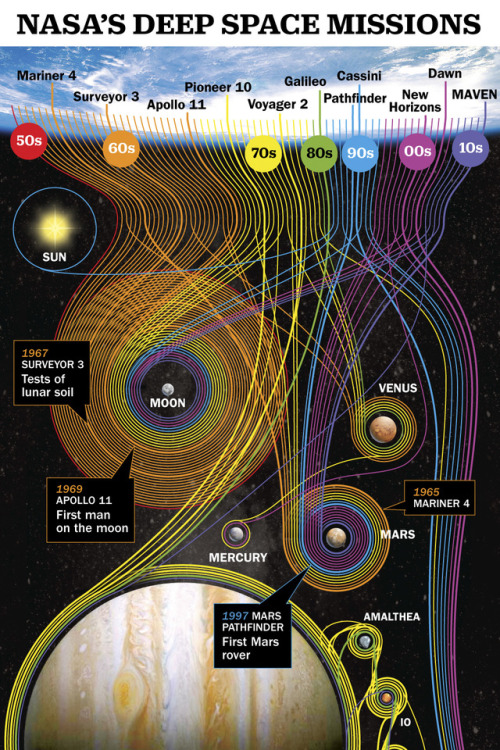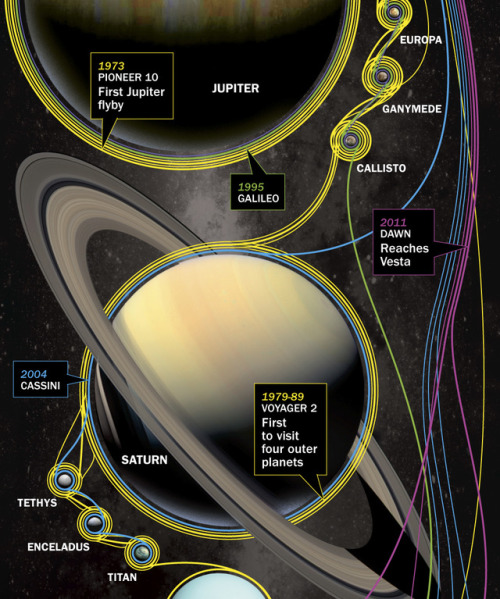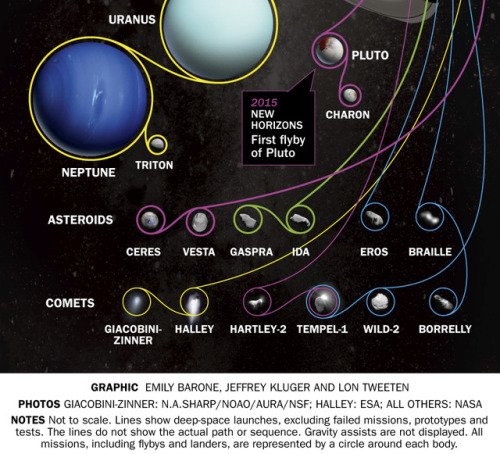fillthevoid-with-space
A podcast project to fill the space in my heart and my time that used to be filled with academic research. In 2018, that space gets filled with... MORE SPACE! Cheerfully researched, painstakingly edited, informal as hell, definitely worth everyone's time.
243 posts
Latest Posts by fillthevoid-with-space
The world's oldest story? Astronomers say global myths about 'seven sisters' stars may reach back 100,000 years https://phys.org/news/2020-12-world-oldest-story-astronomers-global.html

Holy shit, this is cool!
So many cultures call the Pleiades some variation of the "seven sisters" despite only having six visible stars. There only appear to be six because two of the stars are so close together as to appear as one.
The myths also mention one sister leaving or hiding to explain why there's only six. And based off observations and measurements, those two that are so close together used to be visibly separate. One literally has moved to hide.
And based off the similarities between the more commonly known Greek myth and the Aboriginal Australian myth, plus some other stuff, this myth could possibly even date back to when humanity still all resided in Africa!

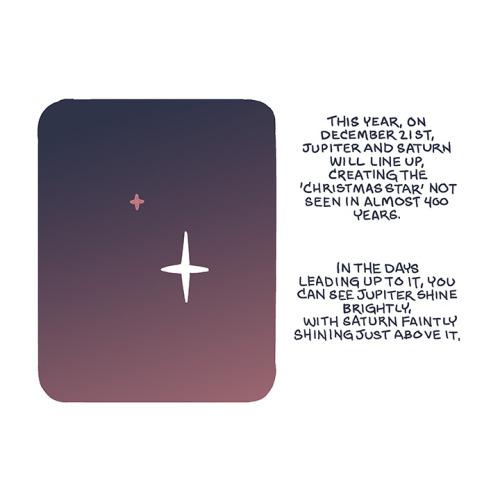

Description: A four panel comic. In the first two panels, me and my father are squinting at the night sky before I brighten and declare that ‘OH! I see it!’ In the next panel is the night sky with two stars. One bright one in the lower right center and a slightly dimmer one just above and to the left of the first one. Text reads: ‘This year, on December 21st, Jupiter and Saturn will line up, creating the ‘Christmas Star’ not seen for almost 400 years. In the days leading up to it, you can see Jupiter shine brightly, with Saturn faintly shining just above it.’ In the final panel I am closing my window and looking up at the sky. Captions read: ‘I keep looking up, finding and refinding it.’ And ‘The planets are always there, but this moment makes it all seem so fleeting.’

Where to look, and when.

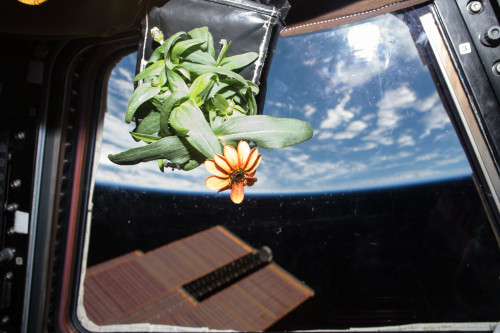

Take a moment, look outside your window. 🌷🌼
Today is the #FirstDayOfSpring in the Northern Hemisphere, also known as the vernal equinox.
#DYK Earth’s tilted axis causes the season? Throughout the year, different parts of Earth receive the Sun’s most direct rays. So, when the North Pole tilts toward the Sun, it’s summer in the Northern Hemisphere. And when the South Pole tilts toward the Sun, it’s winter in the Northern Hemisphere.
These images are of Zinnias. They are part of the flowering crop experiment that began aboard the International Space Station on Nov. 16, 2015, when NASA astronaut Kjell Lindgren activated the Veggie system and its rooting “pillows” containing zinnia seeds.
Make sure to follow us on Tumblr for your regular dose of space: http://nasa.tumblr.com.
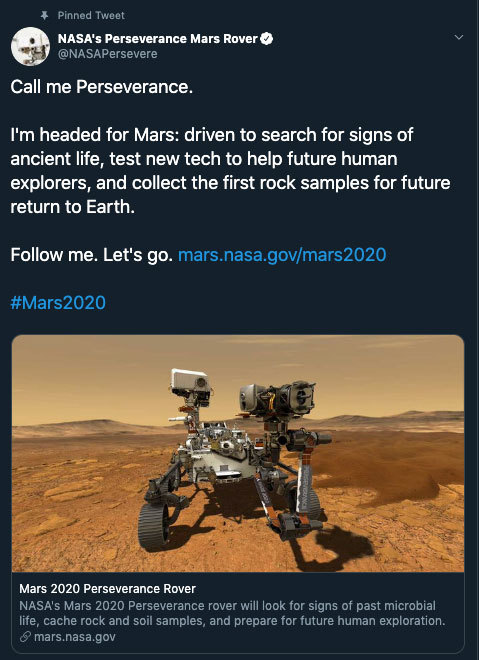
Allow us to reintroduce someone … the name’s Perseverance.
With this new name, our Mars 2020 rover has now come to life! Chosen by middle school student Alex Mather, Perseverance helps to remind ourselves that no matter what obstacles we face, whether it’s on the way to reaching our goals or on the way to Mars, we will push through. In Alex’s own words,
“We are a species of explorers, and we will meet many setbacks on the way to Mars. However, we can persevere. We, not as a nation but as humans, will not give up. The human race will always persevere into the future.”
Welcome to the family. ❤️
Make sure to follow us on Tumblr for your regular dose of space: http://nasa.tumblr.com.

I went stargazing in early August of this year (2019) and I want to suggest a few options that will hopefully make this sort of trip accessible to people who are curious about stargazing but haven’t tried it yet. I talk through the process of finding the right time and location, selecting campsites, preparing some tools to maintain your nightvision, and using an app to figure out stars and constellations more easily.
Below the cut are the transcript, sources, and music credits. Send me any topic suggestions via Tumblr message (you don’t need an account to do this, just submit as anonymous). You can also tweet at me on Twitter at @HDandtheVoid, or you can ask me to my face if you know me in real life. Subscribe on iTunes to get the new episodes of my semi-monthly podcast, and I’d love if you could rate and review it. Go ahead and tell friends if you think they’d like to hear it, too!
(The next episode is undecided, but I’m hoping to have it out for September.)
Transcript
Sources
Dark Site Finder
SkyView Lite
Intro Music: ‘Better Times Will Come’ by No Luck Club off their album Prosperity
Filler Music: me singing ‘House of Gold’ by Twenty-One Pilots off their album Vessel
me singing a parody of ‘Mexican Wine’ by Fountains of Wayne off their album Welcome Interstate Managers
Outro Music: ‘Fields of Russia’ by Mutefish off their album On Draught
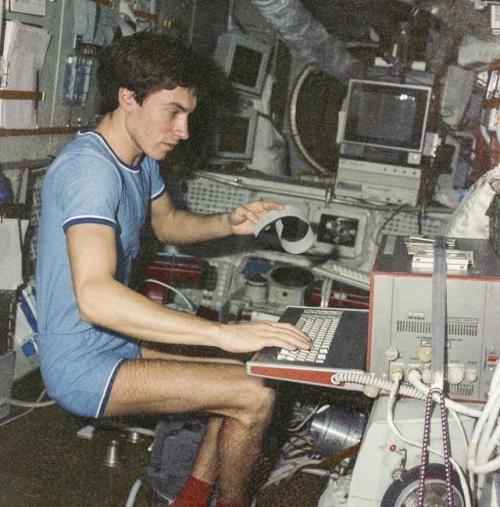
Soviet Cosmonaut Sergei Krikalev stuck in space during the collapse of the Soviet Union in 1991
Unable to return home, he ended up having to stay in space until further notice.
The cosmonaut eventually returned back to earth on March 25, 1992, after 10 months in orbit - to a nation that was very different to what it was when he had left. The Soviet Union had fractured into 15 nations, presidents had changed, and even his hometown of Leningrad had become St. Petersburg.
Interestingly, at the time, Krikalev was supposed to serve in the military reserves, and was almost issued a warrant for desertion – before the army realised that their reserve soldier was not even on the planet.
Happy long weekend to folks in the US who are lucky enough to HAVE a long weekend! I finally fulfilled my promise to bring you an episode on comets—I didn’t last month but I had a good reason, and that reason was black holes. Now you can learn about comets! I’ve likewise talked about comets before, but now I go in-depth on what they are, some great comets throughout human history, and some of the missions we’ve sent out to collect info on comets.
Below the cut are the glossary, transcript, a timeline of all the people I mention, sources, and music credits. Send me any topic suggestions via Tumblr message (you don’t need an account to do this, just submit as anonymous). You can also tweet at me on Twitter at @HDandtheVoid, or you can ask me to my face if you know me in real life. Subscribe on iTunes to get the new episodes of my semi-monthly podcast, and please please please rate and review it. Go ahead and tell friends if you think they’d like to hear it, too!
(The next episode is... not decided, or even thought about much. It’ll go up at the end of June if I come up with a topic, though!)
Glossary
coma - the cloud of dust and gas particles that is burned off of a comet and trails behind it, helping to form the comet’s tail.
comet - a small, icy body that orbits the Sun. When its orbit takes it close to the Sun, the comet warms up and releases gases and debris that produce a visible atmosphere, sometimes called the comet’s tail. (ep. 8, 9, 33)
hyperbolic comets - comets which will only ever enter our solar system once.
long period comets - comets come near our Sun for brief times every few thousand years, following egg-shaped elliptical orbits that often send them beyond Pluto before they return to the Sun.
short-period comets - comets that orbit the Sun closely and show up at regular intervals.
sungrazing comets - comets which come within about 850,000 miles from the Sun at their perihelion, though many of these kinds of comets come even closer, to within a few thousand miles at perihelion.
perihelion - a comet’s closest approach to the Sun in its orbit.
Transcript
Timeline
Ephorus of Cyme (c. 400-330 BCE), Greek
Taqi ad-Din (1526–1585), Turkish
Tycho Brahe (1546-1601), Danish
Gottfried Kirch (1639-1710), German
Isaac Newton (1643-1727), English
Eusebio Kino (1645-1711), Spanish
Edmund Halley (1656-1742), English
Battista Donati (1826-1873), Italian
Jérôme Eugène Coggia (1849-1919), French
Heinrich Kreutz (1854-1907), German
Frank Skjellerup (1875-1952), Australian
Edmundo Maristany (1895-1983), Argentinian
Sylvain Arend (1902-1992), Belgian
Georges Roland (1922-1991), Belgian
Eugene Shoemaker (1928-1997), American
Carolyn Shoemaker (1929- ), American
Tsutomu Seki (1930- ), Japanese
Richard Martin West (1941- ), Danish
Kaoru Ikeya (1943- ), Japanese
David H. Levy (1948- ), Canadian
Thomas Bopp (1949-2018), American
Yuji Hyakutake (1950- ), Japanese
Robert McNaught (1956- ), Scottish-Australian
Alan Hale (1958- ), American
Terry Lovejoy (1966- ), Australian
Sources
Comets via Cool Cosmos (August 2013)
Comet Introduction via Views of the Solar System
On Hyperbolic Comets by David W. Hughes (1991)
What is a Sungrazing Comet? via NASA (July 2013)
Missions to Comets via NASA
Galileo via NASA
Shoemaker-Levy 9 via NASA
Rosetta Images via ESA (video)
Rosetta spacecraft image archive complete via EarthSky (June 2018)
Intro Music: ‘Better Times Will Come’ by No Luck Club off their album Prosperity
Filler Music: ‘Stories We Build/Stories We Tell’ by José González off his album Vestiges & Claws
Outro Music: ‘Fields of Russia’ by Mutefish off their album On Draught

New Zealand was lovely, but I already touched on what I’d be tempted to talk about with my Southern Stars episode. A person I interviewed as a potential new housemate gave me the idea for this episode because the joy of outer space is truly everywhere and anywhere. The field of astrogeology was not something I had heard of before, though I had indirectly heard of Eugene Shoemaker. I knew the comet Shoemaker-Levy 9 was named after him (and Carolyn Shoemaker, his wife). It turns out he basically founded the modern field of astrogeology! So I talk about him for quite a while, too.
Below the cut are the glossary, transcript, sources, and music credits. Send me any topic suggestions via Tumblr message (you don’t need an account to do this, just submit as anonymous). You can also tweet at me on Twitter at @HDandtheVoid, or you can ask me to my face if you know me in real life. Subscribe on iTunes to get the new episodes of my semi-monthly podcast, and please please please rate and review it. Go ahead and tell friends if you think they’d like to hear it, too!
(The next episode is definitely going to be on famous comets, and I’m hoping to publish that episode in May.)
Glossary
active galaxy - a galaxy with a small core of emission embedded at the center. This core is typically very variable and very bright compared to the rest of the galaxy. These galaxies emit much more energy than they should; this excess energy is found in the infrared, radio, UV, and X-ray regions of the electromagnetic spectrum.
black hole - a region of spacetime where a great deal of mass and energy have been compressed into a relatively small space. Black holes exert such strong gravitational effects that no mass or energy, not even light, can escape from inside them. There are supermassive black holes in galaxies that contribute to the development and life cycle of galaxies.
blazar - a subcategory of active galaxy, it is an extremely bright, distant object, powered by a black hole, which emits massive amounts of energy. It is distinct from a quasar because it is even brighter.
interferometry - a group of techniques to extract information from superimposing electromagnetic waves to create interference. In radio astronomy, this is done by using a wide spread of receivers to look at the same distant object, then bringing that data together with a correlator that can create a larger, clearer picture than an individual radio telescope alone could.
Messier object - a deep-sky object included on a list of 103-110 deep-sky objects made by Charles Messier and his colleagues in the 18th century in an attempt to prevent fuzzy, bright objects from being confused with comets.
torus - a donut shape.
quasar - a distant, massive celestial object that emits extremely large amounts of energy. These star-like objects may reflect a stage in the evolution of some galaxies.
Script/Transcript
Sources
Black Holes, explained via National Geographic
What Is a Black Hole? via NASA
Black Holes via NASA
Black Hole via Swinburne University of Technology
Darkness Visible, Finally: Astronomers Capture First Ever Image of a Black Hole via the New York Times (April 2019)
Event Horizon Telescope
Astronomers Capture First Image of a Black Hole via ESO (April 2019)
How They Took the First Picture of a Black Hole via New York Times (April 2019)
Intro Music: ‘Better Times Will Come’ by No Luck Club off their album Prosperity
Filler Music: ‘Flame On Flame (A Slow Dirge)’ by Kishi Bashi off his album Sonderlust
Outro Music: ‘Fields of Russia’ by Mutefish off their album On Draught










Black Holes Are Real And Spectacular, And So Are Their Event Horizons
“Originally estimated to be slightly larger than its M87 counterpart, the black hole at the center of the Milky Way — known as Sagittarius A* — has not yet had its event horizon imaged. When you observe the Universe, you don’t always get what you expect; sometimes, you get what it gives you. Instead, it was M87’s black hole that came through first, which was a much brighter and a much cleaner signal.
What we’ve found is spectacular. Those dark pixels at the center of the image are actually the silhouette of the event horizon itself. The light that we observe comes from the accelerated, heated matter around it, which must emit electromagnetic radiation. Where the matter exists, it emits radio waves, and the dark circle we see is where the background radio waves are blocked by the event horizon itself.”
We have an event horizon, folks! It wasn’t the one at the center of our galaxy that came through first, but rather the one at the center of Messier 87: a black hole over 1,000 times more massive, but some 2,000 times farther away, than the one contained in the Milky Way. This is an ultramassive black hole that’s almost the size of the entire Solar System, and its event horizon is real.
Come get the full story on what we know, now that we have our image, about black holes in the aftermath of the Event Horizon Telescope!

New Zealand was lovely, but I already touched on what I’d be tempted to talk about with my Southern Stars episode. A person I interviewed as a potential new housemate gave me the idea for this episode because the joy of outer space is truly everywhere and anywhere. The field of astrogeology was not something I had heard of before, though I had indirectly heard of Eugene Shoemaker. I knew the comet Shoemaker-Levy 9 was named after him (and Carolyn Shoemaker, his wife). It turns out he basically founded the modern field of astrogeology! So I talk about him for quite a while, too.
Below the cut are the glossary, transcript, sources, and music credits. Send me any topic suggestions via Tumblr message (you don’t need an account to do this, just submit as anonymous). You can also tweet at me on Twitter at @HDandtheVoid, or you can ask me to my face if you know me in real life. Subscribe on iTunes to get the new episodes of my semi-monthly podcast, and please please please rate and review it. Go ahead and tell friends if you think they’d like to hear it, too!
(The next episode is going to be famous comets, and I’m shooting for an April release.)
Glossary
aeolian processes - the wind’s ability to shape the surface of a planet by eroding, transporting, and depositing materials. Most effective in desert regions, where the sparse vegetation, dry soil, and loose sediments mean these processes have the greatest impact.
albedo features - the International Astronomical Union term for an area of a planet that has a high contrast in color with the surrounding area on a planet’s surface.
chaos terrain - the International Astronomical Union term for where ridges, cracks, and plains on a planet’s surface appear broken and smashed up against each other.
chasma - the International Astronomical Union term for a long, steep-sided, deep surface indentation in a planet’s surface.
colles - the International Astronomical Union term for collections of small, knob-like hills on the surface of a planet.
dorsum - the International Astronomical Union term for a wrinkle-like ridge on a planet’s surface.
facula - the International Astronomical Union term for a bright spot on planets or moons.
fluvial processes - the ways in which rivers and streams impact a planet’s surface by eroding or creating deposits and landforms out of sediment. Sometimes, streams or rivers are associated with glaciers, ice sheets, or ice caps, and then they are called glaciofluvial or fluvioglacial processes.
fossa - the International Astronomical Union term for a long, narrow depression in a planet’s surface.
lacunae - the International Astronomical Union term for irregularly shaped depressions that look like dry lake beds on the surface of Saturn’s moon, Titan.
lobate scarp - the International Astronomical Union term for a curved slope that is probably formed by compressive tectonic movement.
mare - the International Astronomical Union term for a large, circular plain on a planet’s surface.
terra - the International Astronomical Union term for an extensive landmass like a plain or highland.
tesserae - the International Astronomical Union term for regions on the planet Venus that are tiled, polygonal shapes.
vallis - the International Astronomical Union term for a valley on the surface of a planet.
Script/Transcript
Sources
Planetary geology via Wikipedia
Lunar Lobate Scarp via the Lunar Reconnaissance Orbiter Camera
Eugene M. Shoemaker Biographical Memoirs via NASA
Dr. Eugene Shoemaker, 69; Set Record for Finding Comets via The New York Times (July 1997)
Eugene Shoemaker (1928-1997) via NASA Jet Propulsion Lab
Eugene Shoemaker (1928 - 1997) via American Astronomical Society
Gene Shoemaker - Founder of Astrogeology via US Geological Society
Eugene Shoemaker via the Planetary Society
Eugene Shoemaker Ashes Carried on Lunar Prospector via NASA Jet Propulsion Lab
Eugene M. Shoemaker and the Integration of Earth and Sky via GSA Today (April 2001)
Destination Moon by Carolyn C. Porco (Feb 2000)
“I wanted to include something to commemorate Gene’s scientific legacy. It seemed appropriate to choose his favorite photo of Meteor Crater and a photo of the last comet that he and his wife saw together, Comet Hale-Bopp. And somehow, I extracted from the dusty realm of dim memory a passage I had read from Romeo and Juliet long ago that seemed perfect for the occasion.”
Who is an Astrogeologist? via Space Awareness
Careers via the USGS Astrogeology Science Center
“Public Service by contributing to the public knowledge about our Solar System.”
Lunar Calibration via USGS
“The unmatched stability of the lunar surface reflectance (better than one part in 108 per year) makes the Moon attractive as a calibration light source; its radiance can be known with high precision and accuracy. The lunar irradiance is similar in brightness to sunlit land masses on the Earth.”
Video: Astrogeology 1963-2013: Fifty Years of Exploration via the USGS Astrogeology Science Center
Intro Music: ‘Better Times Will Come’ by No Luck Club off their album Prosperity
Filler Music: ‘Muddy Waters’ by LP off her album Lost On You
Outro Music: ‘Fields of Russia’ by Mutefish off their album On Draught

RIP, little buddy.

We’re back in 2019 with an episode that would have been more appropriate to release during hurricane season: a discussion of the Coriolis force! This force was observed centuries ago but takes its name from the scientist who first considered it in terms of theory and physics. It has an impact on a vast range of natural phenomena, from weather patterns to ocean waves to the flights of flies and moths.
Below the cut are the glossary, transcript, a timeline of the people I mention, sources, and music credits. Send me any topic suggestions via Tumblr message (you don’t need an account to do this, just submit as anonymous). You can also tweet at me on Twitter at @HDandtheVoid, or you can ask me to my face if you know me in real life. Subscribe on iTunes to get the new episodes of my so-far-monthly-updated podcast, and please please please rate and review it. Go ahead and tell friends if you think they’d like to hear it, too!
(My thoughts on the next episode are Stephen Hawking, Hedy Lamarr, or famous comets. The next episode will go up in late February.)
Glossary
Coriolis force - a force in a rotating system that acts perpendicular to the direction of motion and to the axis of rotation. On Earth, this tends to deflect moving objects to the right in the Northern Hemisphere and to the left in the Southern Hemisphere.
Ekman transport - the net motion of fluid that results from the balance between Coriolis and turbulent drag forces.
Eötvös effect - the change in perceived gravitational force that results from eastbound or westbound movement on Earth’s surface.
Kelvin waves - an ocean wave that is trapped at the Earth’s equator and along vertical boundaries like coastlines. They move towards the equator when they have a western boundary; towards the poles when they have an eastern boundary; and make a whirlpool when they have a closed boundary, moving counterclockwise in the Northern Hemisphere and clockwise in the Southern Hemisphere.
Lagrange points - five points where three bodies can orbit each other, yet stay in the same position relative to each other in a stable configuration. L1-L3 are in line with each other, while L4 and L5 are at the points of equilateral triangles in the configuration.
prograde - when a planet spins from east to west.
Rossby number - used to determine the relative importance of the centrifugal and Coriolis forces in maps of weather patterns. A small Rossby number indicates that a weather system is strongly affected by Coriolis forces, while a large Rossby number signifies that a system is affected by inertial and centrifugal forces.
Transcript
Timeline
Giovanni Battista Riccioli, Italian (1598-1671)
Francesco Maria Grimaldi, Italian (1618-63)
Joseph-Louis Lagrange, French (1736-1813)
Gaspard-Gustave de Coriolis, French (1792-1843)
Sir William Thompson, AKA Lord Kelvin, Scots-Irish (1824-1907)
Baron Loránd Eötvös de Vásárosnamény, Hungarian (1848-1919)
Ottokar Tumlirz, Austrian (1856-1928)
Fridtjof Nansen, Norwegian (1861-1930)
Vagn Walfrid Ekman, Swedish (1874-1954)
Carl-Gustaf Arvid Rossby, Swedish-born American (1898-1957)
Sources
Coriolis Effect via the University of Oregon
Coriolis Force via Wikipedia
Coriolis effect, two centuries before Coriolis via Physics Today (Aug 2011)
Gaspard-Gustave de Coriolis via Wikipedia
Coriolis effect via National Geographic
Hurricane, cyclone, typhoon, tornado – what’s the difference? via African Reporter (Sep 2017)
Wang, B. Kelvin Waves. University of Hawaii: Honolulu, 2002.
Ocean in Motion: Ekman Transport Background via NASA
Ekman transport via Wikipedia
What is a Geodesist? via Environmental Science
“The Second Coming” by W. B. Yeats via Poetry Foundation
Intro Music: ‘Better Times Will Come’ by No Luck Club off their album Prosperity
Filler Music: ‘Ambergris’ by Tipper off their EP Fathoms
Outro Music: ‘Fields of Russia’ by Mutefish off their album On Draught

I’m back with the last episode of 2018! A conversation with a friend sparked this idea and I just ran with it while I had the inspiration, so please enjoy an episode on the strange and wonderful scales that astronomers have created to quantify data that is very unusual.
Below the cut are the glossary, transcript, sources, and music credits. Send me any topic suggestions via Tumblr message (you don’t need an account for it!). You can also tweet at me on Twitter at @HDandtheVoid, or you can ask me to my face if you know me. Subscribe on iTunes to get the new episodes of my ideally-monthly-updated podcast (I hope I have more inspiration/time in 2019), and please please please rate and review it. Go ahead and tell friends if you think they’d like to hear it, too!
(My thoughts on the next episode are the Coriolus Force, Stephen Hawking, or famous comets. The next episode will go up in 2019, hopefully in early January!)
Glossary
background risk - the average risk from random impacts of space objects with Earth.
Bortle Scale - an objective scale to measure the clarity and effect of light pollution on a night’s stargazing.
Drake Equation - a way to estimate the number of potential active, communicative civilizations in the Milky Way galaxy based on 1) the average rate of star formation in our galaxy 2) the fraction of those stars that have planets 3) the average number of planets that can potentially support life per star with its own orbiting planets 4) the fraction of planets that could support life which actually develop life at some point 5) the fraction of planets with life that actually go on to develop intelligent life and civilizations 6) the fraction of civilizations that develop a technology that releases detectable signs of their existence into space 7) the length of time it would take those civilizations release detectable signals into space.
Hynek Scale - quantifies encounters with UFOs and aliens.
Kardashev Scale - measures how advanced a civilization’s technology is based on their mastery of resources and exploration into space.
METI - Messaging to ExtraTerrestrial Intelligence
Palermo Technical Impact Hazard Scale - categorizes and prioritizes the potential impact risks of objects in space, such as asteroids.
Rio Scale - quantifies the impact of any public announcement regarding evidence of extraterrestrial intelligence.
San Marino Scale - quantifies the impact of sending transmissions from Earth to extraterrestrial intelligence.
SETI - the Search for ExtraTerrestrial Intelligence.
Torino Scale - communicates the risk associated with a particular asteroid or comet’s potential to impact with Earth to the public.
Script/Transcript
Sources
10 Unusual Scientific Scales via Listverse (Sep 2010)
John Bortle’s article on his magnitude scale via Sky and Telescope, July 2006
“I have created a nine-level scale. It is based on nearly 50 years of observing experience. I hope it will prove both enlightening and useful to observers — though it may stun or even horrify some! Should it come into wide use, it would provide a consistent standard for comparing observations with light pollution.”
Bortle dark sky scale via Big Sky Astronomy Club
Bortle dark sky scale via LSU
Palermo Technical Impact Hazard Scale via NASA
The Palermo Scale is the base-10 logarithm of the relative risk.
PS = log10 R.
The relative risk R is given by R = PI / (fB × DT), where PI is the impact probability of the event in question and DT is the time until the potential event, measured in years.
The annual background impact frequency, fB = 0.03 × E-4/5, is the annual probability of an impact event with energy (E, in megatons of TNT) at least as large as the event in question.
Torino Impact Hazard Scale via NASA
Rio Scale via SETI League
San Marino Scale via SETI League
Rio and San Marino Scale history via Wikipedia
Drake Equation via Wikipedia
Nikolai Kardashev via Wikipedia
"energy consumption at ≈4×1019 erg/sec (4 × 1012 watts)."
New Variation of Kardashev Scale Developed via Edgy Labs (June 2018)
J. Allen Hynek's Scale Of UFO Classification via The Night Sky
Hynek's UFO Classification System via The Center for UFO Studies
Intro Music: ‘Better Times Will Come’ by No Luck Club off their album Prosperity
Outro Music: ‘Fields of Russia’ by Mutefish off their album On Draught
This is so sweet! What a nice way to spend a Saturday night.
Make Sure You Observe the Moon on October 20
On Saturday, October 20, NASA will host the ninth annual International Observe the Moon Night. One day each year, everyone on Earth is invited to observe and learn about the Moon together, and to celebrate the cultural and personal connections we all have with our nearest celestial neighbor.
There are a number of ways to celebrate. You can attend an event, host your own, or just look up! Here are 10 of our favorite ways to observe the Moon:
1. Look up

Image credit: NASA’s Scientific Visualization Studio/Ernie Wright
The simplest way to observe the Moon is simply to look up. The Moon is the brightest object in our night sky, the second brightest in our daytime sky and can be seen from all around the world — from the remote and dark Atacama Desert in Chile to the brightly lit streets of Tokyo. On October 20, the near side of the Moon, or the side facing Earth, will be about 80 percent illuminated, rising in the early evening.
See the Moon phase on October 20 or any other day of the year!
2. Peer through a telescope or binoculars

The Moon and Venus are great targets for binoculars. Image Credit: NASA/Bill Dunford
With some magnification help, you will be able to focus in on specific features on the Moon, like the Sea of Tranquility or the bright Copernicus Crater. Download our Moon maps for some guided observing on Saturday.
3. Photograph the Moon

Image credit: NASA/GSFC/ASU
Our Lunar Reconnaissance Orbiter (LRO) has taken more than 20 million images of the Moon, mapping it in stunning detail. You can see featured, captioned images on LRO’s camera website, like the one of Montes Carpatus seen here. And, of course, you can take your own photos from Earth. Check out our tips on photographing the Moon!
4. Take a virtual field trip

Image credit: NASA/JPL-Caltech
Plan a lunar hike with Moontrek. Moontrek is an interactive Moon map made using NASA data from our lunar spacecraft. Fly anywhere you’d like on the Moon, calculate the distance or the elevation of a mountain to plan your lunar hike, or layer attributes of the lunar surface and temperature. If you have a virtual reality headset, you can experience Moontrek in 3D.
5. Touch the topography

Image credit: NASA GSFC/Jacob Richardson
Observe the Moon through touch! If you have access to a 3D printer, you can peruse our library of 3D models and lunar landscapes. This model of the Apollo 11 landing site created by NASA scientist Jacob Richardson, is derived from LRO’s topographic data. Near the center, you can actually feel a tiny dot where astronauts Neil Armstrong and Buzz Aldrin left the Lunar Descent Module.
6. Make Moon art

Image credit: LPI/Andy Shaner
Enjoy artwork of the Moon and create your own! For messy fun, lunar crater paintings demonstrate how the lunar surface changes due to consistent meteorite impacts.
7. Relax on your couch

Image credit: NASA’s Scientific Visualization Studio/Ernie Wright
There are many movies that feature our nearest neighbor, from A Voyage to the Moon by George Melies, to Apollo 13, to the newly released First Man. You can also spend your evening with our lunar playlist on YouTube or this video gallery, learning about the Moon’s role in eclipses, looking at the Moon phases from the far side, and seeing the latest science portrayed in super high resolution. You’ll impress all of your friends with your knowledge of supermoons.
8. Listen to the Moon
Video credit: NASA’s Scientific Visualization Studio/Ernie Wright
Make a playlist of Moon songs. For inspiration, check out this list of lunar tunes. We also recommend LRO’s official music video, The Moon and More, featuring Javier Colon, season 1 winner of NBC’s “The Voice.” Or you can just watch this video featuring “Clair de Lune,” by French composer Claude Debussy, over and over.
9. See the Moon through the eyes of a spacecraft

Image credit: NASA/GSFC/MIT
Visible light is just one tool that we use to explore our universe. Our spacecraft contain many different types of instruments to analyze the Moon’s composition and environment. Review the Moon’s gravity field with data from the GRAIL spacecraft or decipher the maze of this slope map from the laser altimeter onboard LRO. This collection from LRO features images of the Moon’s temperature and topography. You can learn more about our different missions to explore the Moon here.
10. Continue your observations throughout the year

Image credit: NASA’s Scientific Visualization Studio/Ernie Wright
An important part of observing the Moon is to see how it changes over time. International Observe the Moon Night is the perfect time to start a Moon journal. See how the shape of the Moon changes over the course of a month, and keep track of where and what time it rises and sets. Observe the Moon all year long with these tools and techniques!
However you choose to celebrate International Observe the Moon Night, we want to hear about it! Register your participation and share your experiences on social media with #ObserveTheMoon or on our Facebook page. Happy observing!
Make sure to follow us on Tumblr for your regular dose of space: http://nasa.tumblr.com.
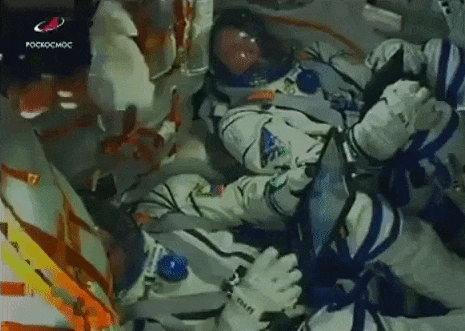
Soyuz MS-10 experiences launch anomaly; crew aborts to safe landing.
One of Russia’s most reliable launchers experienced a rare, in-flight anomaly earlier this morning, forcing the two-man crew of Soyuz MS-10 to abort the mission.
Following a normal liftoff at 4:40am EST (2:40pm local time), a malfunction in the Soyuz FG rocket two minutes into the flight forced Expedition 57 crewmembers Alexey Ovchinin and Nick Hague to abort a manual abort profile. The anomaly occurred immediately following the separation of the rocket’s four strap-on boosters and jettisoning of the Launch Escape System. However, the protective fairing covering the spacecraft during flight through the thick atmosphere was still on, and solid rocket motors attached to the fairing pulled the crew capsule away from the failing booster. Following a ballistic trajectory through the upper atmosphere, the Soyuz’s Descent module separated from the Orbital Module and payload fairing and descended to a safe landing 20 kilometers east of Zezkezhan, Kazakhstan, 34 minutes after launch. Roscosmos reported that the crewmembers experienced around seven times the force of gravity, or 7G’s, during their abort.
Recovery forces reached the landing site immediately following touchdown. Both astronauts were reported to be in good health following their ordeal, and returned to their families at the Baikonur launch site around six hours after liftoff.

Recovery forces at the Soyuz MS-10 emergency landing site. Source: Ruptly.

Soyuz MS-10 crewmembers Alexey Ovchinin and Nick Hague embrace their families following their return to the Baikonur Cosmodrome after today’s launch mishap. Credit: NASA/Bill Ingalls. This marks the first crewed launch mishap of the International Space Station program, the first crewed launch mishap since the Challenger disaster in 1986, and the first crewed Soyuz launch malfunction since Soyuz T-10 in 1983.
That incident saw the two-man crew of Vladimir Titov and Gennady Strekalov abort away from their exploding rocket shortly before its scheduled liftoff time. While no cause of the mishap is currently known, Russian authorities have begun an investigation of the incident and have temporarily grounded all future Soyuz flights. The current three-member crew of Expedition 57 is slated to return to Earth December 13, followed by the launch of Expedition 58 December 20. Following today’s anomaly, it is unclear whether Expedition 57 will remain on orbit longer, or when the next crew will launch to the station. Expedition 57 is able to remain on orbit until early January, when their Soyuz reaches its certified orbital lifetime.

Expedition 57 commander Alexander Gerst captured this image of the Soyuz MS-10 launch from the International Space Station. The anomalous nature of the launch is evidenced by multiple points of light along the ascent path. Source: NASA. Watch NASA TV coverage of the Soyuz MS-10 launch below.
P/c: NASA.

This episode’s been a long time coming because the topic’s come up before. I originally conceived of this podcast as a way for me to learn about space things I’d always taken for granted, and truly, there is nothing closer to home that I’ve just agreed to believe than the statement that the tides are affected by the Moon. What? How? Why? All these questions and some I didn’t even realize I had will be answered in this episode on tidal forces!
Below the cut are my standard glossary, transcript, sources, and music credits. Send me any topic suggestions via Tumblr message (you don’t need an account for it!). You can also tweet at me on Twitter at @HDandtheVoid, or you can ask me to my face if you know me. Subscribe on iTunes to get the new episodes of my maybe now monthly-updated podcast (we’ll see how the weeks unfold), and please please please rate and review it. Go ahead and tell friends if you think they’d like to hear it, too!
(My thoughts on the next episode are Stephen Hawking and his theories, or famous comets. The next episode will go up in September—ideally, September 10th!)
Glossary
barycenter - the common center of mass between two objects that allows them to orbit.
Roche limit - the distance in which a celestial body will disintegrate because of a second celestial body's tidal forces exceeding the first body's gravitational self-attraction, or the force that’s holding it together. Within the Roche limit, orbiting material disperses and forms rings, like how Saturn’s rings are within the Roche zone; outside the limit, material tends to coalesce.
spaghettification - when extreme tidal forces pull an object apart in space.
tidal force - an apparent force (sometimes also called the differential force) that stretches a body towards another, more gravitationally-strong body’s center of mass. This can cause such diverse phenomena as tides, tidal locking, breaking celestial bodies apart to form ring systems within a Roche limit, and in extreme cases, spaghettification. It arises because the gravitational force exerted on one body by another is not constant across its parts: the nearest side is attracted more strongly than the farthest side.
Types of ocean tides:
diurnal tide - a daily tidal cycle with only one high and low tide each lunar day, and a period of a little over 24 hours.
meteorological tide - a tidal change due to weather patterns. Wind, or unusually high or low barometric pressure causes variations between the actual sea level and its predicted height.
mixed tide - a daily tidal cycle with two high and low tides that differ in their peaks. This difference in height between successive high or low tides is called the diurnal inequality. They have a period of 12 hours and 25 minutes.
neap tide - a type of bi-monthly tidal cycle that occurs when the Sun, Earth, and Moon are positioned at a 90-degree angle, so the tidal forces of the Sun are acting against the tidal forces of the Moon. During a neap tide, the difference between high tide and low tide is the least extreme.
semidiurnal tide - a daily tidal cycle with two nearly equal high tides and low tides every lunar day. They have a period of 12 hours and 25 minutes.
spring tide - a type of bi-monthly tidal cycle that occurs when the Sun, Earth, and Moon line up so that the gravitational forces of Sun and Moon are working together to form a large tidal bulge. During a spring tide, the difference between high tide and low tide is at its maximum.
tidal locking - when long-term interaction between two co-orbiting astronomical bodies causes at least one of the bodies to rotate in such a way that one face of the body is always pointed at the body it’s orbiting. This is also called gravitational locking or captured rotation. An example is that the same side of the Moon always faces the Earth, and its synchronous rotation means that it takes just as long to rotate around its own axis as it does to revolve around the Earth.
Script/Transcript
Sources
Tidal Cycles in Tides Explained via beltoforian.de
“a tide is a distortion in the shape of one body induced by the gravitational pull of another nearby object.”
Meteorological effects on tides via the New Zealand Government website
Tides and Water Levels via the National Oceanic and Atmospheric Administration (NOAA)
Tides by R. Nave, my dude, my guy, my friend and yours, of Georgia State University
The Tidal Force by Neil deGrasse Tyson via Hayden Planetarium (Nov 1995)
“A mild increase in distance between two objects can make a large difference in the strength of the tidal force. For example, if the Moon were just twice its current distance from us, then its tidal force on Earth would decrease by a factor of eight. At its current average distance of 240,000 miles from Earth, the Moon manages to create sizable atmospheric, oceanic, and crustal tides by attracting the part of Earth nearest the Moon more strongly than the part of Earth that is farthest. (The Sun is so far away that in spite of its generally strong gravity, its tidal force on Earth amounts to less than half that of the Moon.) The oceans respond most visibly in being stretched toward the direction of the Moon.”
“When Earth's rotation slows down until it exactly matches the orbital period of the Moon, then Earth will no longer be rotating within its oceanic tidal bulge and the Earth-Moon system will have achieved a double tidal lock. In what sounds like an undiscovered wrestling hold, double tidal locks are energetically favorable (like a ball coming to rest at the bottom of a hill), and are thus common in the universe.”
Forget “Earth-Like”—We’ll First Find Aliens on Eyeball Planets via Nautilus (Feb 2015)
High Tide on Io! via NASA (Mar 2012)
Tidal forces and spaghettification via NASA handout
Spaghettification via Cosmic Funnies
Single atoms feel tidal force via Physics World (May 2017)
Robbins, Tom. Still Life with Woodpecker. Bantam Books: New York, 1980.
“Being four times larger than the moon, the earth appeared to dominate. Caught in the earth’s gravitational web, the moon moved around the earth and could never get away. Yet, as any half-awake materialist well knows, that which you hold holds you.”
Sobel, Dava. The Planets. Viking: NY, 2005.
Intro Music: ‘Better Times Will Come’ by No Luck Club off their album Prosperity
Background Music: ‘Sad Business’ by Patients aka Ben Cooper, who primarily releases music as Radical Face but also has at least three other bands or band names he’s working with/has released music as.
Filler Music: ‘It’s Getting Boring by the Sea’ by Blood Red Shoes off their album Box of Secrets
Outro Music: ‘Fields of Russia’ by Mutefish off their album On Draught
I just watched the 4 clearly visible planets march across the sky with the moon in the center, so here’s a short guide to the night sky as the last 3 move across.
mammenxTime lapse of the milky way rolling across the night sky, flanked by the planets Jupiter, Saturn & Mars. Taken from Diskit Ladakh, this place truly has some fantastic unobstructed views of the night sky
In Conversation with the Sun: Parker Solar Probe Communications
Our Sun powers life on Earth. It defines our days, nourishes our crops and even fuels our electrical grids. In our pursuit of knowledge about the universe, we’ve learned so much about the Sun, but in many ways we’re still in conversation with it, curious about its mysteries.

Parker Solar Probe will advance this conversation, flying through the Sun’s atmosphere as close as 3.8 million miles from our star’s surface, more than seven times closer to it than any previous spacecraft. If space were a football field, with Earth at one end and the Sun at the other, Parker would be at the four-yard line, just steps away from the Sun! This journey will revolutionize our understanding of the Sun, its surface and solar winds.

Supporting Parker on its journey to the Sun are our communications networks. Three networks, the Near Earth Network, the Space Network and the Deep Space Network, provide our spacecraft with their communications, delivering their data to mission operations centers. Their services ensure that missions like Parker have communications support from launch through the mission.

For Parker’s launch on Aug. 12, the Delta IV Heavy rocket that sent Parker skyward relied on the Space Network. A team at Goddard Space Flight Center’s Networks Integration Center monitored the launch, ensuring that we maintained tracking and communications data between the rocket and the ground. This data is vital, allowing engineers to make certain that Parker stays on the right path towards its orbit around the Sun.

The Space Network’s constellation of Tracking and Data Relay Satellites (TDRS) enabled constant communications coverage for the rocket as Parker made its way out of Earth’s atmosphere. These satellites fly in geosynchronous orbit, circling Earth in step with its rotation, relaying data from spacecraft at lower altitudes to the ground. The network’s three collections of TDRS over the Atlantic, Pacific and Indian oceans provide enough coverage for continuous communications for satellites in low-Earth orbit.

The Near Earth Network’s Launch Communications Segment tracked early stages of Parker’s launch, testing our brand new ground stations’ ability to provide crucial information about the rocket’s initial velocity (speed) and trajectory (path). When fully operational, it will support launches from the Kennedy spaceport, including upcoming Orion missions. The Launch Communications Segment’s three ground stations are located at Kennedy Space Center; Ponce De Leon, Florida; and Bermuda.

When Parker separated from the Delta IV Heavy, the Deep Space Network took over. Antennas up to 230 feet in diameter at ground stations in California, Australia and Spain are supporting Parker for its 24 orbits around the Sun and the seven Venus flybys that gradually shrink its orbit, bringing it closer and closer to the Sun. The Deep Space Network is delivering data to mission operations centers and will continue to do so as long as Parker is operational.
Near the Sun, radio interference and the heat load on the spacecraft’s antenna makes communicating with Parker a challenge that we must plan for. Parker has three distinct communications phases, each corresponding to a different part of its orbit.
When Parker comes closest to the Sun, the spacecraft will emit a beacon tone that tells engineers on the ground about its health and status, but there will be very little opportunity to command the spacecraft and downlink data. High data rate transmission will only occur during a portion of Parker’s orbit, far from the Sun. The rest of the time, Parker will be in cruise mode, taking measurements and being commanded through a low data rate connection with Earth.

Communications infrastructure is vital to any mission. As Parker journeys ever closer to the center of our solar system, each byte of downlinked data will provide new insight into our Sun. It’s a mission that continues a conversation between us and our star that has lasted many millions of years and will continue for many millions more.
For more information about NASA’s mission to touch the Sun: https://www.nasa.gov/content/goddard/parker-solar-probe
For more information about our satellite communications check out: http://nasa.gov/SCaN
Make sure to follow us on Tumblr for your regular dose of space: http://nasa.tumblr.com.

I’m back! July was nuts! June was also nuts! I’ve missed this podcast, though, and have been thinking about it the entire time because I will never stop loving space. I was working my way through a very meaty book on Edmond Halley and I am here to report on my findings, and also compile some of the things I’ve already said about this cool guy and his cool contributions to science.
Below the cut are my standard glossary, transcript, timeline of people mentioned, sources, and music credits. I take topic suggestions from Tumblr messages, you can tweet at me on Twitter at @HDandtheVoid, or you can ask me to my face if you know me. Subscribe on iTunes to get the new episodes of my increasingly erratically updated podcast, and please please please rate and review it. Go ahead and tell friends if you think they’d like to hear it, too!
(My thoughts on the next episode are Stephen Hawking and his theories or famous comets. The next episode will go up in August—hopefully August 20th!)
Glossary
sidereal year—the time required for the earth to complete an orbit of the sun relative to the stars.
tropical year—the interval at which seasons repeat and the basis for the calendar year.
Script/Transcript
Timeline
Julius Caesar, Roman (100-45 BCE)
Augustus Caesar, Roman (63-14 BCE)
Nicolaus Copernicus, Polish (1473-1543)
Pope Gregory XIII, Italian (1502-1585)
Tycho Brahe, Danish (1546-1601)
Johannes Kepler, German (1571-1630)
Johannes Hevelius, Polish (1611-1687)
Giovanni Cassini (in French, Jean-Dominique Cassini), Italian/French (1625-1712)
Queen Christina, Swedish (1626-1689)
Isaac Newton, English (1643-1727)
John Flamsteed, English (1646-1719)
Elisabeth Hevelius, Polish (1647-1693)
Edmond Halley, English (1656-1742)
John Harrison, English (1693-1776)
Sources
Morse, Stephen P. “The Julian Calendar and why we need to know about it.” The Association of Professional Genealogists Quarterly (March 2014). Accessed July 15, 2018.
Julian Date Converter via the Astronomical Applications Department of the U.S. Naval Observatory.
Hughes, David W. “Edmond Halley, Scientist.” British Astronomical Association (1985). Accessed July 27, 2018.
Cook, Alan. Edmond Halley: Charting the Heavens and the Seas. Clarendon Press: Oxford, 1998.
Intro Music: ‘Better Times Will Come’ by No Luck Club off their album Prosperity
Outro Music: ‘Fields of Russia’ by Mutefish off their album On Draught
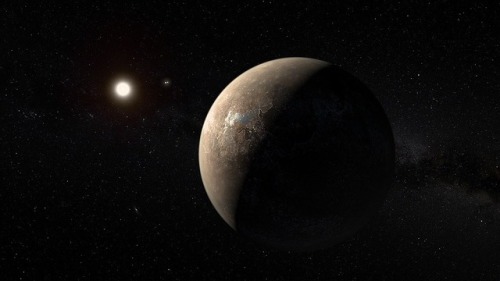
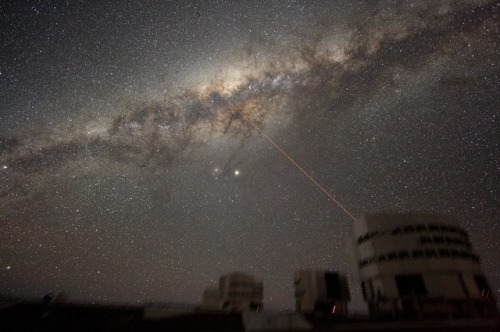
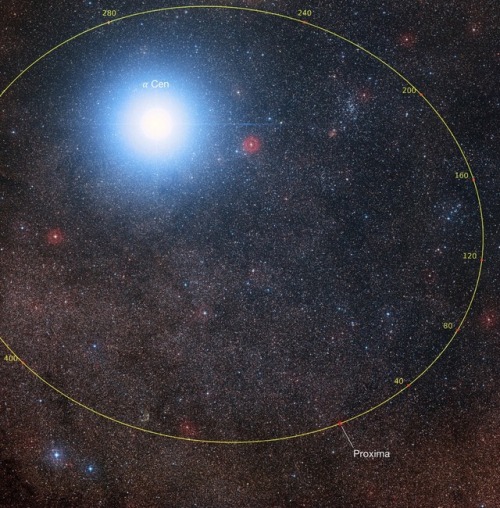
Life orbiting our closest star?
A planet has been found orbiting in the habitable zone of the closest star to earth, 4.2 light years away, named Proxima Centauri. The exoplanet, known as proxima b, has the mass of 1.27 earths but because of the shape of its orbit, the chances of it harbouring liquid water are fantastic. This vastly improves the chances that the planet sustains alien life.
10 Things: Mysterious 'Oumuamua
The interstellar object ‘Oumuamua perplexed scientists in October 2017 as it whipped past Earth at an unusually high speed. This mysterious visitor is the first object ever seen in our solar system that is known to have originated elsewhere. Here are five things we know and five things we don’t know about the first confirmed interstellar object to pass through our solar system.
1. We know it’s not from around here.
The object known as 1I/2017 U1 (and nicknamed ‘Oumuamua) was traveling too fast (196,000 mph, that’s 54 miles per second or 87.3 kilometers per second) to have originated in our solar system. Comets and asteroids from within our solar system move at a slower speed, typically an average of 12 miles per second (19 kilometers per second) . In non-technical terms, 'Oumuamua is an “interstellar vagabond.”

Artist impression of the interstellar object ‘Oumuamua. Credit: ESA/Hubble, NASA, ESO, M. Kornmesser
2. We’re not sure where it came from.
'Oumuamua entered our solar system from the rough direction of the constellation Lyra, but it’s impossible to tell where it originally came from. Thousands of years ago, when 'Oumuamua started to wander from its parent planetary system, the stars were in a different position so it’s impossible to pinpoint its point of origin. It could have been wandering the galaxy for billions of years.

3. We know it’s out of here.
'Oumuamua is headed back out of our solar system and won’t be coming back. It’s rapidly headed in the direction of the constellation Pegasus and will cross the orbit of Neptune in about four years and cover one light year’s distance in about 11,000 years.
4. We don’t really know what it looks like.
We’ve only seen it as a speck of light through a telescope (it is far away and less than half a mile in length), but its unique rotation leads us to believe that it’s elongated like a cigar, about 10 times longer than it is wide. We can’t see it anymore. Artist’s concepts are the best guesses at what it might look like.
5. We know it got a little speed boost.
A rapid response observing campaign allowed us to watch as 'Oumuamua got an unexpected boost in speed. The acceleration slightly changed its course from earlier predictions.
“This additional subtle force on ′Oumuamua likely is caused by jets of gaseous material expelled from its surface,” said Davide Farnocchia of the Center for Near Earth Object Studies (CNEOS) at NASA’s Jet Propulsion Laboratory. “This same kind of outgassing affects the motion of many comets in our solar system.”
6. We know it’s tumbling.
Unusual variations in the comet’s brightness suggest it is rotating on more than one axis.

This illustration shows ‘Oumuamua racing toward the outskirts of our solar system. As the complex rotation of the object makes it difficult to determine the exact shape, there are many models of what it could look like. Credits: NASA/ESA/STScI
7. We don’t know what it’s made of.
Comets in our solar system kick off lots of dust and gas when they get close to the Sun, but 'Oumuamua did not, which led observers to consider defining it as an asteroid.
Karen Meech, an astronomer at the University of Hawaii’s Institute of Astronomy, said small dust grains, present on the surface of most comets, may have eroded away during ′Oumuamua’s long journey through interstellar space. “The more we study ′Oumuamua, the more exciting it gets.” she said. It could be giving off gases that are harder to see than dust, but it’s impossible to know at this point.
8. We knew to expect it.
Just not when. The discovery of an interstellar object has been anticipated for decades. The space between the stars probably has billions and billions of asteroids and comets roaming around independently. Scientists understood that inevitably, some of these small bodies would enter our own solar system. This interstellar visit by ‘Oumuamua reinforces our models of how planetary systems form.

9. We don’t know what it’s doing now.
After January 2018, ’Oumuamua was no longer visible to telescopes, even in space. But scientists continue to analyze the data gathered during the international observing campaign and crack open more mysteries about this unique interstellar visitor.
10. We know there’s a good chance we’ll see another one…eventually.
Because ′Oumuamua is the first interstellar object ever observed in our solar system, researchers caution that it’s difficult to draw general conclusions about this newly-discovered class of celestial bodies. Observations point to the possibility that other star systems regularly eject small comet-like objects and there should be more of them drifting among the stars. Future ground- and space-based surveys could detect more of these interstellar vagabonds, providing a larger sample for scientists to analyze. Adds, Karen Meech, an astronomer at the University of Hawaii’s Institute of Astronomy: “I can hardly wait for the next interstellar object!“
Make sure to follow us on Tumblr for your regular dose of space: http://nasa.tumblr.com.

The inner planets and the outer planets all look like stars from Earth. They are strange stars that move in strange ways, but their appearance depends on how they relate to observers on Earth. They are also affected by their position in relation to the Sun. Planets experience eclipses as well when the Sun, Earth, and planet are all aligned; in the inner planets, this is called a transit, and this has been a source of vast information about the solar system and the planets’ places in that system. In the outer planets, this eclipsing is called opposition. You get to hear about both in this week’s podcast!
Below the cut, I have the glossary, transcript, timeline of astronomers, sources, and music credits. I take topic suggestions from Tumblr messages, or you can tweet at me on Twitter at @HDandtheVoid, or you can ask me to my face if you know me. Please subscribe on iTunes, rate my podcast and maybe review it, and tell friends if you think they’d like to hear it!
(My thoughts on the next episode are Chuck Yeager, Edmond Halley, Stephen Hawking and his theories, or famous comets. The next episode will go up later in June!)
Glossary
aphelion - a planet’s most distant position from the Sun
black drop effect - an optical illusion where a planet nearing the edge of the Sun appears to be connected to the Sun’s edge by a black teardrop.
conjunction - when the Earth, Sun, and another planet in the solar system are aligned so that Earth and the planet are on opposite sides of the Sun.
node - the point where another planet’s orbit crosses the plane of Earth’s orbit. The planets’ orbits are tilted at slightly different angles from each other; for example, Mercury’s orbit is inclined 7 degrees compared to Earth’s orbit. Because Mercury orbits the Sun once every 88 days, it crosses Earth’s orbit every 44 days at these nodes.
opposition - when one of the outer planets crosses the plane of Earth’s orbit opposite the Sun.
perihelion - a planet’s closest position to the Sun
retrograde - the apparent motion of a planet in a direction opposite to that of other bodies within its system, as observed from a particular vantage point.
syzygy - the straight line between three celestial bodies, usually the Sun to the Earth to another planetary body.
transit - when one of the inner planets crosses between the plane of Earth’s orbit and the Sun.
Script/Transcript
Timeline
Bernhard Walther, German (1430-1504)
Johannes Regiomontanus, German (1436-1476)
Willibald Pirckheimer, German (1470-1530)
Nicolaus Copernicus, Polish (1473-1543)
Georg Rheticus, Austrian (1514-1574)
Johannes Kepler, German (1571-1630)
Pierre Gassendi, French (1592-1655)
Johannes Hevelius, Polish (1611-1687)
Jeremiah Horrocks, English (1618-1641)
Edmond Halley, English (1656-1742)
Leonhard Euler, Swiss (1707-1783)
Alexandre Guy Pingré, French (1711-1796)
César-François Cassini de Thury, French (1714-1784)
Maximilian Hell, Hungarian (1720-1792)
Jean-Baptiste Chappe d’Auteroche, French (1722-1769)
James Cook, English (1728-1779)
Charles Mason, English (1728-1786)
Jeremiah Dixon, English (1733-1779)
János Sajnovics, Hungarian (1733-1785)
Thomas Hornsby, English (1733-1810)
Charles Green, English (1734-1771)
Joseph Jérôme Lefrançois de Lalande, French (1732-1807)
Jean Guillaume Wallot, French/German (1743-1794)
Christian VII of Denmark, Danish (1749-1808)
Sources
Mercury Solar Transit (image) via NASA
Mercury Transit of the Sun: Why Is It So Rare? via Space.com (May 2016)
The 2016 Transit of Mercury via NASA
Before the Transit of Mercury: forgotten forerunners of an astronomical revolution via The Guardian (May 2016)
Catalog of Venus Transits via NASA’s Fred Espenak
Mars Opposition via NASA
Mars brighter in 2018 than since 2003 via EarthSky (May 2018)
Opposition of Superior Planets via Hong Kong Observatory
Saturn at Opposition via NASA
Earth between sun and Saturn late June via EarthSky (Jun 2018 [not possible because I’m releasing this podcast in May 2018 but okay])
Uranus at opposition via EarthSky (Oct 2017)
Earth passing between Neptune and sun via EarthSky (Sept 2018 [not possible because I’m releasing this podcast in May 2018 but okay])
Anderson, Mark. The Day the World Discovered the Sun. Da Capo Press: Philadelphia, 2012.
“Visionaries like Edmund Halley had in 1716, for instance, argued that the Venus transit could enable science to trace out a map of the solar system accurate to 99.8 percent or better” (191).
Wulf, Andrea. Chasing Venus: The Race to Measure the Heavens. Alfred A. Knopf: New York, 2012.
Intro Music: ‘Better Times Will Come’ by No Luck Club off their album Prosperity
Filler Music: ‘Cannonballs’ by Hey Marseilles off their album To Travels and Trunks.
Outro Music: ‘Fields of Russia’ by Mutefish off their album On Draught

“As the centuries unfold, millions of artists will live on the moon and paint the moon and Mars as we go out into the universe.”
Today we remember the fourth man to walk on the moon. Astronaut Alan Bean passed away in Houston, at the age of 86.
Bean was the lunar module pilot for Apollo 12 in November 1969, and was commander of Skylab 3 in June 1973. He retired from NASA in 1981 to devote his time to painting.


